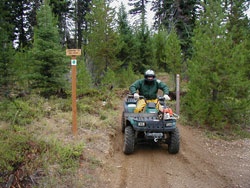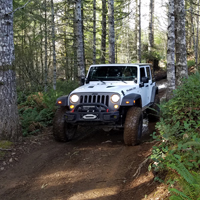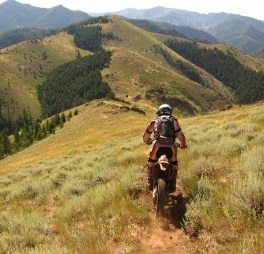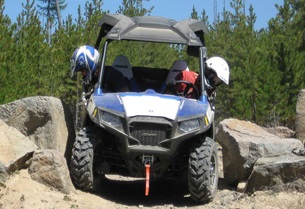States often use different terms to define Off Highway Vehicles (OHV) or All-Terrain Vehicles (ATV).
In Oregon, laws were written using the term All-Terrain Vehicle which encompasses all types of vehicles including motorcycles, 3 wheelers, quads, side-by-sides, sand rails, trucks and SUVs.
There are legal definitions for each type of vehicle and the rules can be different for each for things such as age of operator and where each type of vehicle can be driven. See below for the specific rules.
Operators with a suspended or revoked driver's license may not operate any Class of ATV.
 Class I ATVs are known as four-wheelers, quads, 3-wheelers. They can be 2 or 4 wheel drive. They also include 6x6 ATVs. Polaris Ace is considered a Class IV since it has a steering wheel and seat.
Class I ATVs are known as four-wheelers, quads, 3-wheelers. They can be 2 or 4 wheel drive. They also include 6x6 ATVs. Polaris Ace is considered a Class IV since it has a steering wheel and seat.
Defined:
ORS 801.190
- Vehicle 50 inches wide or less
- Dry weight of 1,200 pounds or less
- Uses handlebars for steering;
- Has a seat designed to be straddled for the operator
- Travels on three or more pneumatic tires designed for off-road use only
Vehicle requirements:
-
ATV Sticker. An ATV Operating Permit is required for your machine if you are operating it on lands open to ATV use. The price is $10 and is valid for two years. Purchase
through our online store.
- Insurance. Liability insurance is not required by for Class I vehicles but strongly encouraged to protect you from a lawsuit if you have an accident.
- Titles. Titles are not required for Class I ATVs, but a title is often required by the bank or insurance company, to finance or insure a vehicle. Contact
Driver and Motor Vehicle Services for vehicle titling information. A title also helps prove ownership if the vehicle is stolen. Class I ATVs cannot be registered to get a license plate.
- Equipment. Meet the safety equipment standards for off-road vehicles. Including seat and foot pegs or floor pan which protects the all rider's feet. Must also have working brakes and a secure fuel tank. Must have a flag when operating on sand and headlights and taillights when operating after dark.
- Mufflers. Adequate muffler to limit sound emissions to 96dBA. Spark arrester during fire season.
- Fire Season. During fire season, there may be extra restrictions on equipment and where you can drive. This depends on the land owner and the timing of the year. As a general rule, during fire season you should have a shovel and fire extinguisher for every vehicle when in the forest. You will also need a muffler and an exhaust system in good working order, which prevents sparks. Some areas will restrict use to improved roads free for vegetation.
Oregon Department of Forestry. US Forest Service, check with each forest.
Operator requirements
- License. All operators must hold a valid
ATV Safety Education Card. Operators with a suspended or revoked Driver License may not operate any Class of ATV.
- Helmets. Youth under 18 must wear a DOT approved helmet with the chin strap fastened.
ORS 821.202
- Youth under 16:
- Must be supervised by an adult who is at least 18 years old and holds a valid ATV Safety Education Card and can provide immediate assistance and direction to the children.
- Must meet
Rider Fit rules, including arm, hand and leg length.
- Must also successfully complete a
hands-on training course
 Class II ATVs include pickup trucks, SUVs, Jeeps, rock crawl vehicles and sand rails. They may be street legal or for off-highway use only.
Class II ATVs include pickup trucks, SUVs, Jeeps, rock crawl vehicles and sand rails. They may be street legal or for off-highway use only.
Vehicles that have an unrestricted license plate are allowed to drive most gravel roads that are open to passenger vehicles, without needing an ATV Permit. They are required to have an ATV Permit when they leave the road, such as operating on trails or the dunes.
Defined: ORS 801.193
- Weighs more than 1,200 pounds or is wider than 50 inches
- Is designed for or capable of cross-country travel on or immediately over land, water, sand, snow, ice, marsh, swampland or other natural terrain
- Is actually being operated off a highway
- Is not a Class IV all-terrain vehicle (side-by-side)
If a side-by-side or quad does not meet the definition of their category, such as after installing tracks, then they become a Class II vehicle.
Operator requirements:
- License. Must have a valid Driver License or Instruction Driver Permit. Operators with a suspended or revoked Driver License may not operate any Class of ATV.
- Helmets. Youth under 18 must wear a DOT approved helmet with the chin strap fastened unless vehicle is registered (street legal) and has a roof or roll bar.
ORS 821.202
- Seat Belts. Youth under 16 must wear safety restraints in accordance with
ORS 811.210, including child seats for children weighing less than 40lbs
Vehicle Requirements:
- Insurance. Liability insurance is required by law for all Class II vehicles (ref: ORS 806.012 & 806.020). Contact your insurance company for more information.
- Titles. Titles are required for vehicles with a registration (license plate). Vehicles without a plate, such as a sand rail or rock crawler, do not need a title, but a title is often required by the bank or insurance company, to finance or insure a vehicle. A title also helps to prove ownership if the vehicle is stolen. Contact
Driver and Motor Vehicle Services for vehicle titling information.
- Equipment. Meet the
safety equipment standards for off road vehicles. Including: 2lbs. fire extinguisher, roll bar or enclosed cab, seats and seat belts for operator and all passengers, and windshield wipers, if equipped with a windshield. Must also have working brakes, a secure fuel tank and floor pan which protects rider's feet. Must have a flag when operating on sand and headlights and taillights when operating after dark.
- Mufflers. Adequate muffler to limit sound emissions to 96dBA.
- ATV Sticker. An ATV Operating Permit is required for your machine if you are operating it on lands open to ATV use. The price is $10 and is valid for two years. Purchase through
our online store. If the vehicle has a license plate, it needs an ATV sticker on trails or sand dunes. If you are operating a vehicle with a valid license plate on roads which are open to passenger vehicles (such as logging roads), then you do not need a sticker.
- Fire Season. During fire season, there may be extra restrictions on equipment and where you can drive. This depends on the land owner and the timing of the year. As a general rule, during fire season you should have a shovel and fire extinguisher for every vehicle when in the forest. You will also need a muffler and an exhaust system in good working order, which prevents sparks. Some areas will restrict use to improved roads free for vegetation.
Oregon Department of Forestry. US Forest Service, check with each forest.

Class III ATVs are 2 wheeled motorcycles. This includes dual sport (street legal) motorcycles that are used on trails.
Vehicles that have an unrestricted license plate are allowed to drive most gravel roads that are open to passenger vehicles, without needing an ATV Permit. They are required to have an ATV Permit when they leave the road, such as operating on trails or the dunes.
(Photo courtesy Tom Niemela)
Defined:
ORS 801.194
- Vehicles traveling on two tires.
- Is actually being operated off highway.
Vehicle requirements:
-
ATV Sticker. An ATV Operating Permit is required for your machine if you are operating it on lands open to ATV use. The price is $10 and is valid for two years. Purchase
through our online store.
- Insurance. Liability insurance is not required by for Class III ATVs, unless they are street legal.
- Titles. Titles are not required for Class III ATVs, but a title is often required by the bank or insurance company, to finance or insure a vehicle. Contact
Driver and Motor Vehicle Services for vehicle titling information. A title also helps prove ownership if the vehicle is stolen. Class III ATVs can only be registered to get a license plate if they were manufactured for highway use. Off-road motorcycles cannot be converted to be street legal.
- Equipment. Meet the safety equipment standards for off-road vehicles. Including seat and foot pegs or floor pan which protects the all rider's feet. Must also have working brakes and a secure fuel tank. Must have a flag when operating on sand and headlights and taillights when operating after dark.
- Mufflers. Adequate muffler to limit sound emissions to 96 dBA. Spark arrester during fire season.
- Fire Season. During fire season, there may be extra restrictions on equipment and where you can drive. This depends on the land owner and the timing of the year. As a general rule, during fire season you should have a shovel and fire extinguisher for every vehicle when in the forest. You will also need a muffler and an exhaust system in good working order, which prevents sparks. Some areas will restrict use to improved roads free for vegetation.
Oregon Department of Forestry. US Forest Service, check with each forest.
Operator requirements
- License. All operators must hold a valid
ATV Safety Education Card. Operators with a suspended or revoked Driver License may not operate any Class of ATV.
- Helmets. Youth under 18 must wear a DOT approved helmet with the chin strap fastened.
ORS 821.202
- Youth under 16:
- Must be supervised by an adult who is at least 18 years old and holds a valid
ATV Safety Education Card and can provide immediate assistance and direction to the children.
- Must be at least 7 years old.
- Must also successfully complete a
hands-on training course
If a ski and tracks are installed for use in the snow, then the vehicle becomes a snowmobile and needs a snowmobile title and registration.
 Class IV ATVs are commonly known as side-by-sides. Basically they have a steering wheel, non-straddle seat and roll cage. The industry produces Recreational Off-Highway Vehicle (ROV) and Utility Task Vehicle (UTV) and they both are considered Class IV ATVs.
Class IV ATVs are commonly known as side-by-sides. Basically they have a steering wheel, non-straddle seat and roll cage. The industry produces Recreational Off-Highway Vehicle (ROV) and Utility Task Vehicle (UTV) and they both are considered Class IV ATVs.
The single seat Polaris Ace is also a Class IV. Land managers may designate trails by width and limit side-by-sides by 50 or 65 inches due to narrow bridges or tight trees.
Defined: ORS 801.194
- Is 75 inches wide or less at its widest point and was originally manufactured for off-road use only.
- Has a dry weight of 3,500 pounds or less
- Has non-straddle seating
- Has a steering wheel for steering control
- Travels on four or more tires designed for off-road use only.
Vehicle requirements:
-
ATV Sticker. An ATV Operating Permit is required for your machine if you are operating it on lands open to ATV use. The price is $10 and is valid for two years. Purchase
through our online store.
- Insurance. Liability insurance is not required by for Class IV vehicles but strongly encouraged to protect you from a lawsuit if you have an accident.
- Titles. Titles are not required for Class IV ATVs, but a title is often required by the bank or insurance company, to finance or insure a vehicle. Contact Driver and Motor Vehicle Services for vehicle titling information. A title also helps prove ownership if the vehicle is stolen. Class IV ATVs cannot be registered to get a license plate.
- Equipment. Meet the safety equipment standards for off-road vehicles. Including: 2lbs. fire extinguisher, roll bar or enclosed cab, seats and seat belts for operator and all passengers. When the vehicle is operated on a highway and the vehicle is equipped with a windshield, the top edge of which is at least six inches above the steering wheel, the vehicle must be equipped with a windshield wiper. Must also have working brakes, a secure fuel tank and floor pan which protects rider's feet. Must have a flag when operating on sand and headlights and taillights when operating after dark.
- Mufflers. Adequate muffler to limit sound emissions to 96 dBA. Spark arrester during fire season.
- Fire Season. During fire season, there may be extra restrictions on equipment and where you can drive. This depends on the land owner and the timing of the year. As a general rule, during fire season you should have a shovel and fire extinguisher for every vehicle when in the forest. You will also need a muffler and an exhaust system in good working order, which prevents sparks. Some areas will restrict use to improved roads free for vegetation.
Oregon Department of Forestry. US Forest Service, check with each forest.
Operator requirements (applies only to public OHV riding areas):
Adults:
- License. Must have a valid Driver License. Operators with a suspended or revoked Driver License may not operate any Class of ATV.
Youth:
- If under age of 16, may operate a youth machine, with ATV Safety Education Card AND must be supervised by an adult who is at least 18 years old and holds a valid ATV Safety Education Card and can provide immediate assistance and direction to the children.
- Can only operate a machine that has a manufacturer recommendation for their age.
- Seat Belts. Youth under 16 must wear safety restraints in accordance with ORS 811.210, including child seats for children weighing less than 40lbs
- Helmets. Youth under 18 must wear a DOT approved helmet with the chin strap fastened. ORS 821.202